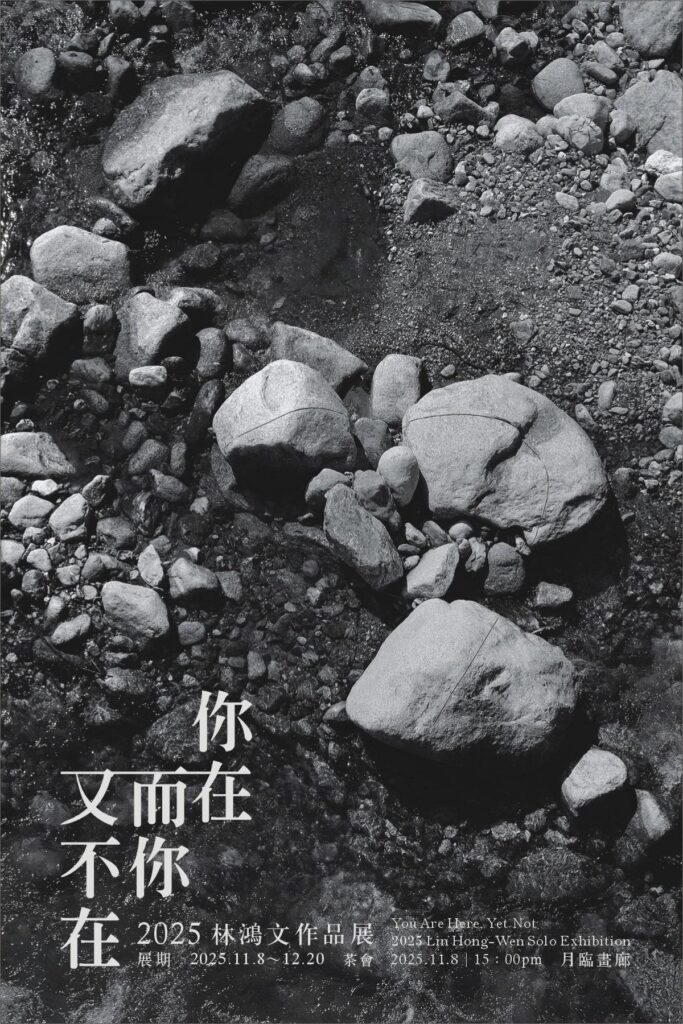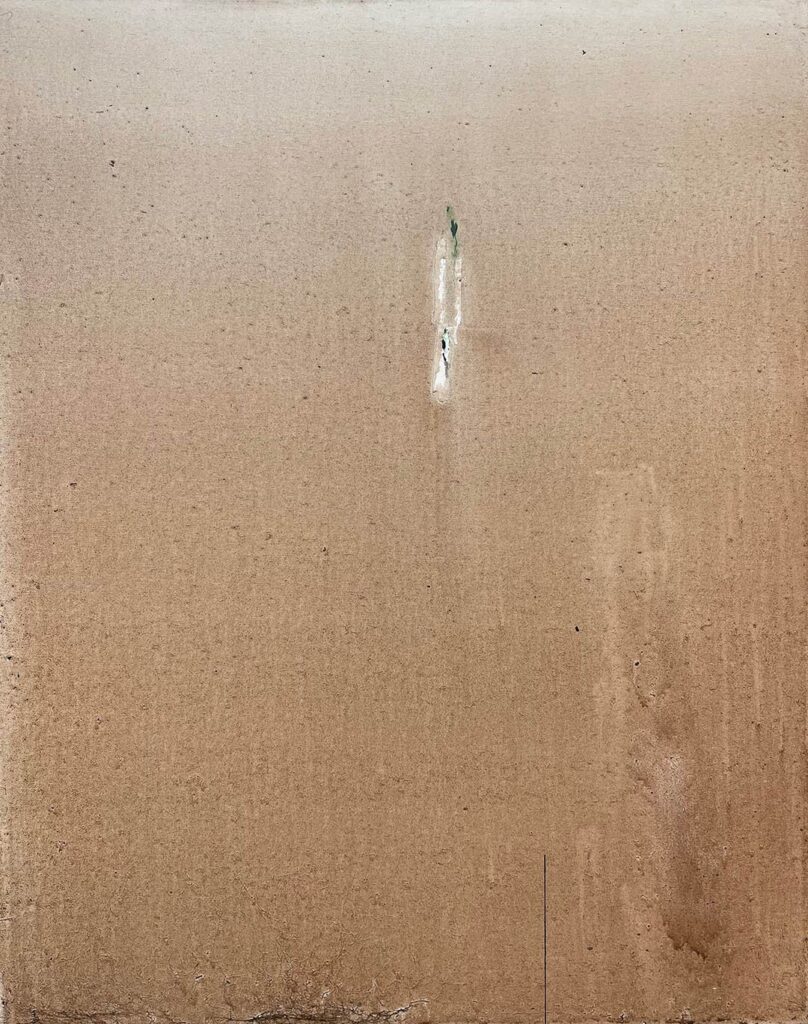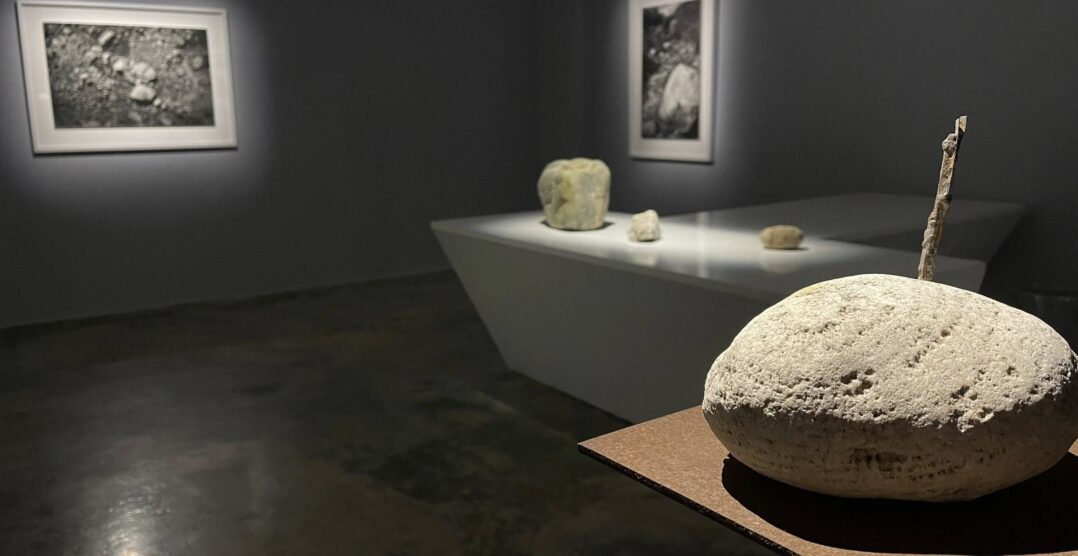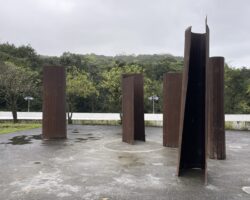
畫一條線在日日步履間 試談林鴻文的創作
文/許遠達 國立臺南藝術大學藝術史學系 助理教授
經常關注林鴻文的人可能會注意到,他的文章文字很特別,字詞排列、甚至是字本身的運用,都會讓讀文的人頓蹬頓蹬。他的句子行文像是在行與行的空間裡,剪開文法,雖然仍有說詞。字本身漂淡著意義,以形狀架構著本身視覺的寓味,不按照文法常規地堆疊、渲染著意向,像是他的繪畫語法。
林鴻文近來的繪畫,乍看是單色的平面背景,上鑲嵌按裝著形狀,或著漂浮著瞇著眼睛的線條。但走近細看卻可以看到他作品背景,在稀薄渲染與流動下的深度空間,像是在他工作室夜晚時分,望向無光的自然空間,那樣層層疊疊的色彩漸層。簡單可以說是暗黑,林鴻文卻把色調調高,讓眼睛望去看似無物的黑,呈現豐富的空間層次。
林鴻文經常說他的造型繪畫不僅是「寫實作品」還是「超級社會寫實作品」。一樣的,一如他一貫的字詞運用,這樣的說明比之於他的造型作品,不禁讓聽者躊躇於他語句的字裡行間。這樣的說法其實不難理解,應該說,他的創作就是他現實的狀況的展現,不是大家慣性理解的外表描繪的「寫實作品」。他的「寫實」其實是他自己在對環境的感知與自我思考過後的「真實」描繪,不以亦步亦趨的表象外在的物像寫型,而是內在感受的時間疊合現實。也就是說,他的作品可能是某個當下心境凝結的表述,也可以是一陣子積累的雲淡風輕。而這些感受的積累,並不僅止於來自自然,當然也就他走踏在都市社會裡的情緒起落。
有些作品,從我一位經常夜間微拜訪的酒客的經驗看來。像是鏡頭拉開落地窗於林間的光暈,天南地北的語句在暗夜裡,飄散著閒暇或材米油鹽。背景是單色的無限層疊,黃光溢出落地窗暈染著樹木的輪廓。淋酒時光的話語,被一字字挑開,橫豎撇奈被拆解成透著顏色的點線,話語意義被畫筆刷成帶著氣氛的線條,或是點狀的情緒節奏。或是,在臉書上訴說著那一張他烈日下,他揮汗割推著割草機,處理連下了一兩星期以來乘著風可以成浪的草皮。草坡起伏,草皮綠成了層次豐富的深邃背景。陽光在樹葉間落下了斑駁的點,緩緩移動,陪伴著藝術家剪裁著自然,在草皮上一點一線地皴點著豐滿的情緒線條。
或是,某些城市光怪陸離的視覺或事件,不斷地扦著情緒。在回家的途中,讓兩邊的鄉野景色將情緒褪染出邊界。漂浮著、鑲嵌於背景空間上的色塊,或輕或重地平衡著現實與內在的兩端。很難說定,那是什麼情緒,只能說是情緒疊合成了那樣的造型與色彩。
近來,林鴻文的作品背景色更薄了,像是清晨的薄霧,或午夜望向果園或淺山極度微光下,藉於視覺、記憶與想像間的厚度,那些是必須要有心親近才看得到的畫面細節。那是居於鄉野四季緩慢轉換下的自我觀照,在日出日落不動不靜下的落筆。難說是今日還是昨日的,前一刻還是後一刻的念頭,但就是在每次的情緒後添了感動。林鴻文的作品不是驚天動地的波動,或是波瀾壯闊的潑灑,而是那些現實日常生活時時刻刻的痕跡筆畫。
Tracing a Line Through the Everyday: On the Art of Lin Hong-Wen
By Hsu Yuan-Ta, Assistant Professor, Department of Art History, Tainan National University of the Arts
Readers familiar with Lin Hong-Wen will quickly recognize the singularity of his prose. His writing unsettles conventional syntax—words stumble, falter, and stall, as if the act of reading itself were momentarily obstructed (dùn dèng). Phrases are suspended in midair, cutting across grammar with deliberate ruptures. Meaning drifts like a haze, while the visual form of the characters carries its own resonance. His texts, much like his paintings, refuse linear clarity; they are built upon disjunction, rhythm, and the visual weight of language itself.
Lin’s recent paintings, at first glance, present muted monochrome fields punctuated by embedded forms or lines that hover with half-closed eyes. Yet as one moves closer, these surfaces disclose strata of washes and subtle flows—a depth of space that recalls looking out from his studio at night, into the dark, lightless expanse of nature. What initially appears as unbroken blackness unfolds into gradated layers, revealing unexpected richness. Lin raises the tonal register so that the void becomes alive, shimmering with nuanced space.
He frequently insists that his paintings are not merely “realist works” but “super social realist works.” This statement, characteristically, destabilizes more than it clarifies, leaving the listener suspended in his phrasing. Yet such a claim points to the heart of his practice. For Lin, realism is not a faithful imitation of appearances but a distillation of lived truth—shaped through perception, reflection, and time. His realism is interior rather than exterior: a condensation of moods, a layering of temporality, a transcription of emotional resonance. His works embody both the fleeting crystallization of a momentary state and the gradual accumulation of sensibilities, drawn as much from the pulse of the city as from the quietude of nature.
Some paintings can be read through the lens of convivial nights and the rhythms of drinking (lín-jiǔ). They resemble the widening of a cinematic frame, opening from a floor-to-ceiling window into a forested glow. Words, drifting in the night air, oscillate between idle chatter and the mundane. A monochrome background stretches infinitely, while yellow light bleeds outward, softening the outlines of trees. Conversations dissolve into strokes—characters disassembled into chromatic dots and lines, their meanings absorbed into painterly rhythms of mood and atmosphere. At other times, Lin’s social media accounts document the corporeal labor of mowing vast lawns beneath a punishing sun: sweat-soaked, he cuts through waves of grass grown tall after weeks of rain. The undulating slopes become a rich ground of layered green, dappled by shifting sunlight, as though each stroke of the mower were itself a painterly mark inscribing emotion into landscape.
Elsewhere, fragments of urban spectacle pierce and agitate his sensibility. Returning home, the rural margins blur and absorb the excesses of city life, leaving behind fields of color that float and embed themselves in the pictorial ground. These blocks, light or heavy, calibrate the fragile balance between inner states and external reality. What they represent is not any single identifiable emotion but rather the sediment of feeling, crystallized as form and hue.
In his most recent works, Lin has pared his backgrounds to a near-transparency—like the faint veil of dawn mist, or the barely perceptible gleam of orchards and hills under midnight light. These spaces, suspended between vision, memory, and imagination, yield details only to those who linger with care. They are meditations drawn from the slow revolutions of rural seasons, from the stillness of sunrise and sunset, from moments resistant to fixed chronology. They are neither fully of today nor yesterday, but arise in the quiet after each emotion has passed, leaving behind a trace of resonance.
Abstract.
This essay examines the recent practice of Lin Hong-Wen, an abstract painter whose work is marked by philosophical depth and poetic resonance. Lin’s writing, with its deliberate ruptures and syntactic disjunctions, parallels the visual grammar of his painting—where monochrome grounds open into layered depths and floating forms. Rejecting conventional notions of realism, Lin proposes a “super social realism” that seeks not to replicate appearances but to distill lived experience. His canvases register the condensation of fleeting moods and the gradual accumulation of sensibilities, shaped equally by rural rhythms and urban intensities. Whether through the quiet solitude of dawn mist, the corporeal labor of mowing grass, or the conviviality of nights spent drinking, Lin translates moments into chromatic fields where memory, perception, and imagination converge. Subtle rather than spectacular, his paintings embody a poetics of presence, inscribing the traces of everyday life into resonant pictorial form.


「你在而你又不在」林鴻文個展
展期 2025.11.8 (六) – 12.20(六)
地點 月臨畫廊一館 (台中市西區英才路589巷6號1F)
展覽相關資訊 :
https://www.moongallery.com.tw/gallery_detail.asp?st=2&cat=355








